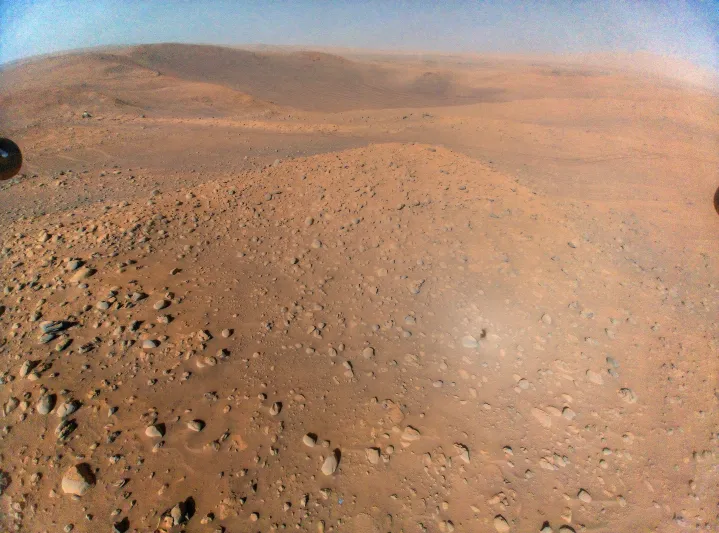
Everyone’s favorite Mars double act, the Ingenuity helicopter and the Perseverance rover, have been traveling together recently after spending several months apart. As they explore the site of an ancient river delta in the Jezero crater, the pair have snapped images of each other that were recently shared by NASA.
The Perseverance’s cameras caught this great shot of Ingenuity, which, as noted in the rover’s Twitter post, is now considerably dustier than it was when it first deployed from under the rover’s belly two years ago. In its two years on the red planet, Ingenuity has made more than 50 flights, which is incredible when you consider that it was designed to perform just five flights. During that time, Ingenuity had to take a break from long flights to deal with the cold martian winter, but since the beginning of the year, the helicopter has been back, making some of its longest flights yet.

Got a closer look at the #MarsHelicopter than I’ve had in quite a while. Ingenuity is a little dustier since its first flight two years ago today (!!) – but it’s looking mighty good after 50 flights! pic.twitter.com/dfGsKbu7Uj
— NASA’s Perseverance Mars Rover (@NASAPersevere) April 19, 2023
Ingenuity and Perseverance are currently close to each other because Ingenuity has finished its solo adventures exploring Mars from the air. Now, it is the helicopter’s job to help the rover by scouting ahead and looking for a clear route for the rover to drive along. The pair are in a region close to the Belva Crater, which they are exploring as part of the rover’s Upper Fan campaign. Scientists are hoping to learn about how the crater was shaped by studying the history of water on the planet.
“Belva Crater has an interesting depth-to-diameter ratio compared to other martian craters, as it is shallower than expected,” writes Perseverance student collaborator Eleni Ravanis. “The crater walls also appear to have been breached. Is the crater infilled, or were the rims eroded down? Were the crater walls breached by water, or ice? Our science team hopes to answer these questions by taking a closer look at the crater walls from our vantage point.”
As for Ingenuity, during its 51st flight, it took a gorgeous shot of Mars from the air with a special photo bomb: Perseverance is visible in the top-left of the image. This is the view that Ingenuity sees from 40 feet about the surface.

Ingenuity is gearing up for its 52nd flight, expected to take place soon, in which it will travel nearly 1,200 feet across the surface and rise up to 40 feet in the air.
Editors’ Recommendations
-
NASA’s InSight lander looks into Mars to study the planet’s core
-
NASA’s Ingenuity helicopter sets two flight records on Mars
-
NASA’s plucky Mars helicopter eyes another flight record
-
See Mars’s beautiful Jezero Crater from the air in flyover video
-
How Europe’s ExoMars rover plans to get to Mars without Russia

Georgina is the Digital Trends space writer, covering human space exploration, planetary science, and cosmology. She specializes in current and future exploration of Mars. She has previously written about science, technology, and security topics for websites like SlashGear, Engadget, and Futurism. She has a master’s degree in neuroscience and a PhD in psychology.
How much fuel is left in this 20-year-old Mars orbiter?
Designing, building, and launching a spacecraft is hugely expensive. That’s why NASA missions to Mars are designed with the hope that they’ll last as long as possible — like the famous Opportunity rover which was supposed to last for 90 days and managed to keep going for 15 years. The longer a mission can keep running, the more data it can collect, and the more we can learn from it.
That’s true for the orbiters which travel around Mars as well as the rovers which explore its surface, like the Mars Odyssey spacecraft which was launched in 2001 and has been in orbit around Mars for more than 20 years. But the orbiter can’t keep going forever as it will eventually run out of fuel, so figuring out exactly how much fuel is left is important — but it also turned out to be more complicated than the NASA engineers were expecting.
Read more
See the Ingenuity helicopter’s stunning image of a Martian sunset
The tiny helicopter Ingenuity is continuing to explore Mars, gearing up for its 47th flight. That’s a pretty stunning achievement, considering it was originally designed to perform just five flights and has had to deal with changing seasonal conditions including colder temperatures and dropping atmospheric pressure.
Despite the inhospitable environment, the helicopter continues to operate and recently made its longest flight in almost a year. And now, NASA’s Jet Propulsion Laboratory has shared an image taken by Ingenuity during its 45th flight which shows an otherworldly sunset, as the sun slinks over the Martian horizon.
Read more
Rovers could explore lava tubes on Mars or the moon using breadcrumbs
When looking for safe places for astronauts to stay when they venture away from Earth to new moons and planets, one strong contender is that they should stay underground. Being underground means more protection from harmful space radiation and less exposure to weather events, and nature already creates environments that could be ideal bases in the form of lava tubes. Created when molten lava flows under the surface, lava tubes are thought to exist on both Mars and the moon, providing potential shelter for human explorers.
Now, new research from engineers at the University of Arizona proposes a method for using robots to scout out lava tubes for use as habitats ahead of the arrival of human astronauts. “Lava tubes and caves would make perfect habitats for astronauts because you don’t have to build a structure; you are shielded from harmful cosmic radiation, so all you need to do is make it pretty and cozy,” said lead author of the research, Wolfgang Fink, in a statement.
Read more



